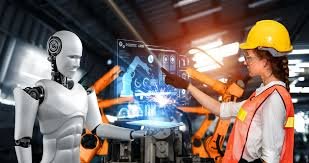Introduction
The rise of robotics and automation is revolutionizing industries and reshaping the future of work, transportation, healthcare, and beyond. From autonomous vehicles and robotic surgery to industrial automation and smart manufacturing, robotics technology is driving efficiency, innovation, and productivity on a global scale. In this article, we delve into the robotic revolution, exploring how automation is shaping the future of technology and society in “Tech Trends 2023: Exploring the Future of Technology.”
Tech Trends 2023: Exploring the Future of Technology
Industry 4.0: The Rise of Smart Manufacturing
Industry 4.0 represents a new era of industrial automation, characterized by the integration of cyber-physical systems, the Internet of Things (IoT), and artificial intelligence (AI) into manufacturing processes. In 2023, smart factories leverage robotics and automation to optimize production, reduce costs, and enhance quality control. From collaborative robots (cobots) working alongside human workers to fully autonomous production lines, Industry 4.0 is revolutionizing the manufacturing landscape, driving innovation and competitiveness in the global economy.
Smart Robotics: Enhancing Efficiency and Flexibility
Smart robotics technologies play a central role in Industry 4.0, enabling manufacturers to automate repetitive tasks, streamline workflows, and adapt quickly to changing market demands. In 2023, advanced robotics platforms equipped with sensors, cameras, and AI algorithms perform a wide range of tasks, from assembly and packaging to inspection and maintenance. By integrating robotics into production processes, manufacturers can improve efficiency, accuracy, and safety, while also creating new opportunities for customization and personalization.
Transportation: Pioneering Autonomous Mobility
The transportation sector is undergoing a seismic shift with the advent of autonomous vehicles and drones, paving the way for safer, more efficient, and sustainable mobility solutions. In 2023, autonomous vehicles equipped with advanced sensors, LiDAR, and AI algorithms navigate roads with increasing autonomy, promising to revolutionize transportation systems and reduce traffic congestion, accidents, and emissions. From self-driving cars and trucks to aerial drones and delivery robots, autonomous mobility is reshaping the future of transportation, logistics, and urban planning.
Urban Air Mobility: Reimagining City Transportation
Urban air mobility (UAM) represents a futuristic vision of urban transportation, where autonomous flying vehicles provide on-demand aerial transportation within and between cities. In 2023, companies and startups are developing electric vertical takeoff and landing (eVTOL) aircraft and passenger drones capable of ferrying passengers across urban landscapes quickly and efficiently. By leveraging eVTOL technology and air traffic management systems, UAM promises to alleviate traffic congestion, reduce commute times, and enhance urban mobility for millions of people worldwide.
Healthcare: Revolutionizing Patient Care with Robotics
The healthcare industry is embracing robotics and automation to enhance patient care, improve surgical outcomes, and increase operational efficiency. In 2023, robotic surgery systems enable surgeons to perform minimally invasive procedures with precision and control, reducing patient recovery times and complications. From robot-assisted surgeries and telemedicine consultations to automated pharmacy dispensing and patient monitoring, robotics technology is transforming every aspect of healthcare delivery, from diagnosis to treatment to recovery.
Medical Robotics: Advancing Surgical Precision and Accessibility
Medical robotics technologies empower healthcare professionals to deliver safer, more effective treatments and procedures, from complex surgeries to rehabilitation therapies. In 2023, robotic exoskeletons help patients regain mobility and independence after injury or illness, while telepresence robots enable remote consultations and virtual patient monitoring. By expanding access to specialized care and improving treatment outcomes, medical robotics are revolutionizing healthcare delivery and improving the quality of life for patients worldwide.
FAQs (Frequently Asked Questions)
- What is Industry 4.0, and how is it transforming manufacturing?
- How do autonomous vehicles and drones revolutionize transportation?
- What are some applications of robotics in healthcare?
- How do robotics technologies enhance efficiency and safety in industrial settings?
- What role do robotics and automation play in the future of work?
- How does automation impact job creation and workforce development?
Conclusion
As we conclude our exploration of the robotic revolution, one thing becomes clear: automation is shaping the future of technology and society in profound and transformative ways. From smart manufacturing and autonomous transportation to robotic surgery and healthcare automation, robotics technologies are driving efficiency, innovation, and progress across industries and sectors. As we embrace the opportunities and challenges of the robotic revolution, let us strive to harness the power of automation for the benefit of all, creating a future where technology serves humanity and fosters prosperity, sustainability, and inclusivity for generations to come.
